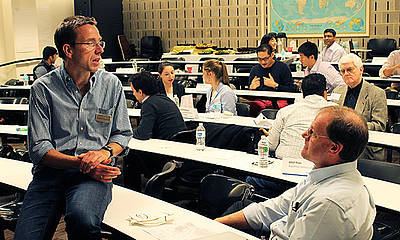MOOCs – a threat to full-time MBA programmes?
Prior to the 21st century, education was predominantly delivered via live performances. Internet communication fundamentally altered the way business schools, schools and universities worldwide teach their students. The emergence of Massively Open Online Courses (MOOCs) for example has opened up business education to a broad audience that might otherwise not be able to afford it. Business schools have graciously shared their knowledge.
But how have these mostly free of charge events impacted MBA education as a whole? The US based Wharton School has examined this impact that could potentially even develop into a threat. MBA Channel correspondent Barbara Barkhausen spoke about the school’s MOOCs with Christian Terwiesch, a Professor of Operations and Information Management at The Wharton School of the University of Pennsylvania, who has co-authored the report.
Wharton’s MOOCs have proven extremely successful. What has been on offer and what experienced the highest demand so far?
Wharton has offered the "Wharton Foundation Series" on Coursera. This is a bundle of four courses: accounting, operations, finance, and marketing. Operations had the highest total demand, as it has already had four offerings. Accounting had the highest demand within a single offering. Together, the foundations series has reached over 1 million students. We also have a course on gamification and a course on design on Coursera.
How many students finish your MOOC courses on average?
A typical MOOC for us attracts between 50,000 and 100,000 students that enrol in one offering. Of these, only 5-7 per cent complete the course. This is a pattern that we see all over Coursera. Recall that enrolment is free, so you enrol to check out a course, since dropping is without cost.
Are the MOOCs a direct competition or even a danger for the future of the traditional MBA course in your eyes?
No, they are not. We do not feel threatened by the MOOC. The bigger concern is the technology that is embedded in and that enables the MOOC. This technology, we call it the super-text, poses the much bigger threat. We argue in the report that the super-text can be deployed in multiple ways. In particular, we outline three scenarios how the super text will impact our schools: (a) the increase in productivity will lead to more output, be it in the form of extra courses, better teaching to our present students, or in the form of free MOOCs, (b) the increase in productivity will lead to a decline in faculty, as the overall output is limited by demand and (c) the super-text technology will lead to an unbundling of the services presently provided by the business schools.
Can you compare a business school’s costs for a traditional MBA course with a MOOC course for us?
It costs us about $50-$60k to teach a traditional MBA course to some 50 or so students. A MOOC costs us about $70k to develop for over 100k students and thus over 5k completions. The key differences are that MOOCs don't include the costs of research and MOOCs have huge scale economies.
Couldn’t business schools use MOOCs more as a marketing tool to build up the school’s reputation as well as draw students into their full-time programmes?
Yes, that is exactly our point. Right now, we build reputation via research. But research is very expensive. We find that we spend some $400k per research paper published in a good journal. For that you can launch multiple MOOCs. So, yes, MOOCs are offering a great promise for brand building.
Interview by Barbara Barkhausen

